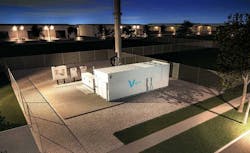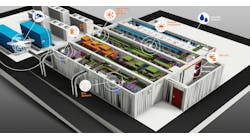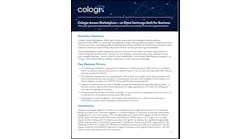A Vision for the Edge: Vapor IO Refines Network, Data Center Designs
As content and data move to the edge of the network, new infrastructure will be needed to manage it. This provides a greenfield opportunity to make the edge the new design frontier for networks and data centers.
That’s the approach for edge computing specialist Vapor IO, which has outlined out its vision for the technical architecture to drive the next phase of growth at the edge of the network. The startup said it has begun deploying a network design that delivers exceptional reliability across a low-latency network of colocation sites, knitted together with both wired and wireless connections.
Vapor IO unveiled a micro modular data center to serve as the building block for its edge ambitions, optimized for deployments at the base of telecom towers. The design packs 150kW of compute into an enclosure, mounting its round Vapor Chamber rack enclosure on a motorized turntable.
Vapor IO is just one of a group of startups targeting the market for edge computing, which moves content closer to users, improving the experience for streaming video and gaming. It’s a hot trend, as the emergence of the Internet of Things, AI and autonomous cars reinforces the need for data centers in new places. Other players in this space include EdgeMicro, DartPoints, DataBank and Switch.
In a niche with many layers and strategies, Vapor IO is moving quickly to lay out a vision for a sophisticated platform, using cloud concepts to meld software and hardware. It also has partnerships that offer the ability to scale quickly if needed.
A Partnership With Scale
Vapor IO has teamed with Crown Castle, the nation’s largest provider of wireless telecom towers, to create an edge computing network called Project Volutus offering fully-managed micro data centers at the base of cell towers. Crown Castle, which operates 40,000 wireless sites, has made a minority investment in Vapor IO to accelerate the project.
Today Vapor IO unveiled two key components of its network:
- Vapor Kinetic Edge, a technical architecture for combining multiple micro data centers into a virtual data center that can span an entire city and deliver up to 12 “nines” of availability.
- Vapor Edge Module (VEM), a custom micro modular data center design to support multi-tenant colocation environments at the base of telecom towers.
In approaching its edge design, Vapor IO has sought to leverage both software and hardware to create a holistic approach, using wired and wireless networks to tie together the cloud and edge devices, which could mean everything from a smartphone to an autonomous car. Vapor IO sees its software as a key differentiator.
“The edge is not a box,” said Cole Crawford, founder & CEO of Vapor IO. “It’s a highly-interconnected suite of hardware, software and connectivity working together in concert. Our Kinetic Edge architecture and the Vapor Edge Module deliver true edge cloud by being part of a complete portfolio of products, including our flagship Vapor Chamber, all of which work together to deliver on customer needs.
“It’s not enough to provide bent sheet metal,” Crawford added. “You need to tie all of the components together with thoughtful engineering and software so you can algorithmically and autonomically orchestrate the edge.”
Cloud Concepts Inform a High-Availability Cluster Design
Vapor IO’s Kinetic Edge uses software and high-speed connectivity to bring multiple micro data center facilities into a single virtual facility with multiple availability zones. Modules are meshed together with high-speed fiber across a group of data centers. The design builds upon the “availability zone” approach popularized by Amazon Web Services, creating a cluster of local data centers to easily hand off data and traffic.
A diagram illustrating how Vapor IO micro data centers can be clustered to create a high-availability zone. (Image: Vapor IO)
Crawford says this infrastructure will be attractive to developers, who can use Vapor’s APIs to build “edge native” applications that respond to changing environmental conditions, delivering features like software-based failover and real-time load balancing. That also includes workload migration for devices in motion, a critical feature for supporting autonomous vehicles that will traverse multiple networks at highway speed.
Crawford emphasizes that the Vapor Edge Module and Kinetic Edge are not just concepts. A prototype installation is underway in the Chicago area.
“We are deploying Kinetic Edge right now,” said Crawford. “We will be delivering Vapor Edge modules in 2018 in new markets. We start by placing multiple Vapor edge data centers in a geographic region, spaced 15 to 20 kilometers apart. We then connect them with high speed fiber so that our software can stitch these sites together into a highly-reliable and customizable edge presence that can span an entire city or region.”
On the reliability front, Vapor IO says its Kinetic Edge concept builds upon software-based reliability systems used by hyperscale providers, who can shift workloads between data centers to route around outages, reducing the need for redundant equipment in every data center. Joining five data centers with a low-latency network enables data to easily move between locations, with software monitoring environmental conditions that can replicate workloads, ensuring no single point of failure..
Crawford says this design allows a Kinetic Edge installation with five sites to deliver 12 “nines” of availability (99.9999999999% uptime), without the costs of replicating critical infrastructure at each site.
The Data Center Building Block
On the hardware front, the company also unveiled the Vapor Edge Module, a multi-tenant modular data center optimized to provide colocation services at the base of telecom towers. The module is built in a factory, and can support 150 kW of capacity in an N+1 design with generator support (and up to 200kW in an N configuration with no generator).
The design actually features two pieces, with one module for housing racks and interconnection equipment, and another module for cooling. This allows Vapor Io to deploy different types of cooling modules in different climates. Cooling module options include direct expansion (refrigerant), or chilled water, or adiabatic economizers.
The specs for the Vapor Edge Module. (Image: Vapor IO)
The prefabricated design includes power distribution, cooling, fire suppression, security, and racking systems for IT equipment. The module is designed to operate in “lights out” mode, with no staff present.
The IT equipment is housed inside a Vapor Chamber, a round enclosure that can support six racks positioned in a ring. Cool air enters from the exterior, and waste heat is contained in a central vertical column, allowing airflow to be managed with minimal use of fans.
In the module design, each Vapor Chamber rests on a motorized turntable, which can rotate 180 degrees in each direction to position racks in a service access alcove, which is only as wide as the rack opening. This provides security, while reducing the amount of space needed for housing and servicing the equipment. Each rack can be further secured by up to four chambers. each housing 9 to 12 rack units of IT. Each rack features locking doors, allowing tenants to lease capacity in partial rack increments.
Several views of the Vapor Edge Module, showing the security and rack management design. (Image: Vapor IO)
Vapor IO software continuously monitors the critical environment and makes automatic adjustments based on actual IT load. The software supports remote operations and security via an API. A web-based application enables operators to monitor multiple locations, create dashboards and reports, and perform enhanced remote hands operations.
Crawford says the Vapor Edge Module can be delivered on an 18-wheeler and will be able to fit under virtually all bridges, a complication sometimes seen in delivery of modular data centers. That’s important, as Crown Castle operates 40,000 mobile access locations across America, including sites in major cities and small towns.
Crawford says the Vapor Edge Module will appeal to landowners, building owners, infrastructure providers and other entities looking to build out an edge presence quickly. “We’ve removed vast amounts of complexity and cost, and designed this to be multi-tenant,” he said. “What we’ve done is moved the carrier hotel, metro office and data center to the edge.”
Explore the evolving world of edge computing further through Data Center Frontier’s special report series and ongoing coverage.






